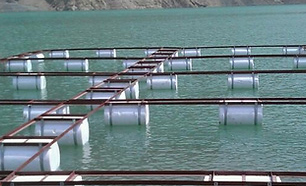
According to the data released by the Ministry of Agriculture and Rural Affairs, by the end of 2023, more than 20000 gravity cages, 40 truss cages and 4 breeding factory ship have been built under the accelerated high-quality development of deep and offshore aquaculture in coastal areas; A total of 43.98 million cubic meters of deep sea aquaculture water have been built, with a production capacity of 393000 tons, which is 3.3 times and 2.4 times higher than the initial stage of the 13th Five Year Plan, respectively.
Aquatic products are important agricultural products that can increase the total amount of food and alleviate the supply pressure of main grains and livestock and poultry products. In recent years, with the development of the economy and society, the rigid demand for marine products among residents has increased. In the context of the tightening of land and nearshore aquaculture space, deep-sea aquaculture with vast potential is an important way to build a "blue granary" and demand food from the ocean.
"Compared with traditional aquaculture methods, deep-sea aquaculture has more advanced facilities and equipment, leading aquaculture technology, and a more complete industrial chain." The relevant person in charge of the Fisheries and Fisheries Administration of the Ministry of Agriculture and Rural Affairs introduced that developing deep-sea aquaculture can not only increase the supply of high-quality aquatic products, but also effectively drive the development of related industries such as aquaculture breeding and prefabricated vegetable processing, extend the industrial chain, and enhance the value chain, Effectively promoting the modernization and upgrading of marine aquaculture.
From the perspective of facility and equipment level, the gravity net cage used in deep-sea aquaculture can achieve stable aquaculture in open waters at a depth of 20 meters, which is currently the most important and mature aquaculture model in deep-sea aquaculture; Various types of truss type net cages have been developed, including fully submersible, semi submersible, floating, and bottom mounted. The level of mechanization, automation, and intelligence in aquaculture has significantly improved.
From the perspective of supporting aquaculture technology, for deep-sea aquaculture, coastal regions have developed a number of suitable new varieties based on actual conditions. The breeding work of high-value varieties such as Atlantic salmon, Xu's flatfish, and military grass is also accelerating.
From the perspective of marine ecological protection, deep-sea aquaculture is usually set up in areas with better water quality, faster flow rate, and larger ecological capacity. Fish grow in natural environments with fewer diseases and less medication. The waste from aquaculture can be properly treated and has a relatively small impact on the environment.
At present, the agglomeration effect of the deep-sea aquaculture industry has begun to emerge. Shandong Province has set up deep and offshore aquaculture fisheries in Qingdao, Yantai, Rizhao and other places, and built the world's first 100000 ton aquaculture factory ship "Guoxin No.1"; Fujian Province has cultivated and formed a truss type net cage cluster in the Dinghai Bay of Lianjiang, which has significantly increased the selling price of wild simulated yellow croaker; Guangdong Province, relying on the large market of the Guangdong Hong Kong Macao Greater Bay Area, has formed a deep and distant sea aquaculture agglomeration area in the waters of Zhuhai Zhenxiang Island; Hainan Province will integrate deep sea aquaculture with leisure marine ranching in the Ledong Longqi Bay area, achieving a win-win situation in terms of economic and ecological benefits.
"The production capacity of a 100000 ton aquaculture factory ship is equivalent to 5000 mu of pond farms on land and more than 3000 nearshore fish rafts." Zhou Rong, deputy director of the Achievements Transformation Division of the Fisheries Machinery and Instrument Research Institute of the Chinese Academy of Fishery Sciences, told reporters that from the perspective of industrial development, it is crucial to break the limitations of previous production methods as soon as possible, The key is to establish a new production mode that focuses on animal husbandry, integrates land and sea resources, and integrates the entire production chain. The research and development of factory ship for large-scale aquaculture in the Far East Sea is guided by this, forming a transformative innovation effect, which not only guarantees and improves the quality of aquatic products substantially, but also enables aquaculture to embark on a sustainable development path of "production does not compete for land, water does not occupy water source, and emissions do not affect the environment".
As an emerging industry, deep-sea aquaculture involves multiple aspects such as aquaculture production, equipment construction, ecological protection, technological innovation, inspection and registration, safety production, and sea use management. Among them, optimizing the management of aquaculture sea use and promoting ecological aquaculture sea use methods are important foundations for promoting the upgrading of marine aquaculture industry and building "blue granaries".
On December 13, 2023, the Notice on Optimizing the Management of Aquaculture Seas was officially issued, proposing a series of policy measures from six aspects: scientifically determining the scale and layout of aquaculture Seas, classifying and controlling new aquaculture Seas, and prudently disposing of existing aquaculture Seas.
In terms of sea use management for deep and offshore aquaculture, the Notice mentioned that it is necessary to expand the deep and offshore areas suitable for fishing, optimize the layout of sea use for aquaculture, actively support the use of sea for deep and offshore aquaculture and marine ranching, and accelerate the construction and application of gravity cages, truss cages, aquaculture factory ship and other deep and offshore aquaculture fisheries.
The relevant person in charge of the Fisheries and Fisheries Administration of the Ministry of Agriculture and Rural Affairs stated that accelerating the development of deep-sea aquaculture should adhere to scientific layout, and on the basis of fully evaluating economic, safety, environmental and other factors, plan and layout deep-sea aquaculture to promote standardized and orderly development of the industry; Adhere to technology leadership, guided by industrial demand, gather strength to increase research and development of key core technologies, and enhance independent innovation capabilities; Adhere to green ecology, integrate the concept of green development throughout the entire process of marine aquaculture, and promote the coordinated development of production and ecology; Adhere to safe development, firmly establish the concept of safe development, and effectively ensure production safety, biological safety, product quality safety, and national food security.

